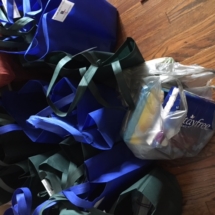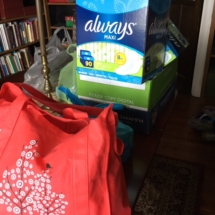I am an Episcopal priest, and so I wear a religious collar. You have seen these collars. The Roman style is a tab, a white square surrounded by black cotton, worn around the neck. The Anglican style is wraparound, white, about an inch and a half thick. You have to purchase a special shirt that can hold the buttons that keep the collar in place. My church tradition favors the Anglican collar, and I have a collection of black, grey and white shirts that I wear to work that will accommodate this peculiar ornament that I hope will identify my priestly vocation.
People ask me various questions about the collar. Question 1: Is it comfortable? After more than a dozen years of wearing it, I don’t really feel it anymore. It is like a wedding ring or a wristwatch. You know it is there, but you don’t notice it. It can get hot in the summer though. Question 2: What is it made of? Mine is plastic; some are cloth. You have to iron and starch the cloth ones so mine is plastic. Question 3: Where do you get them? There are catalogues of church supplies and priestly vestments and clothing. You can get them online. And no, I will not let you borrow it for Halloween.
But people rarely ask me why I wear it. I think they assume it is a requirement of the job, though many of my colleagues in this area don’t wear one except on Sundays. I don’t have to wear it. No one monitors my compliance. I choose to. My choice to wear a collar, to wear something that sets me intentionally apart, does not have to do with my need to be an authority. Any priest will tell you that those days are gone. There is little privilege to being a priest, which is probably a good thing. So I don’t wear it to be powerful, or to avoid speeding tickets or to get a free lunch.
In fact, for me, wearing a collar is a spiritual discipline hopefully grounded in humility. Wearing a collar doesn’t make my life easier. Actually it makes it more likely someone will want to tell me their problems or ask me for money. It makes it more likely that I will get asked why there are starving children or what I believe about complicated social issues. It makes it more likely that I will be challenged about the hypocrisy of religion, or that I will be told about how Sunday mornings are too valuable to waste on church. People love to tell me they are spiritual but not religious.
And frankly, that is just fine. I love the hard questions. I love the challenges. I love that people ask me to pray for them or their relatives and friends. I love it when I am a reminder of when church might have been important in someone’s life or a sign of hope that it might be again. I love it when I can assure people that I believe in a God of love and mercy and compassion. I love to let people know how much it means to me to be a priest.
I wear a collar because what I believe matters to me. Just like someone might wear a cross or a Star of David or a burka, or carry a set of prayer beads. I deeply respect when people are willing to proclaim who they are, are proud to be a part of something bigger than themselves, especially those who proclaim it with humility and graciousness. I aspire to that. And that is why I wear a collar.


